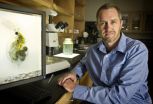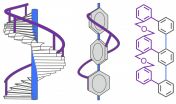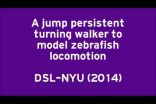(Press-News.org) The tree has been an effective model of evolution for 150 years, but a Rice University computer scientist believes it's far too simple to illustrate the breadth of current knowledge.
Rice researcher Luay Nakhleh and his group have developed PhyloNet, an open-source software package that accounts for horizontal as well as vertical inheritance of genetic material among genomes. His "maximum likelihood" method, detailed this month in the Proceedings of the National Academy of Sciences, allows PhyloNet to infer network models that better describe the evolution of certain groups of species than do tree models.
"Inferring" in this case means analyzing genes to determine their evolutionary history with the highest probability - the maximum likelihood - of connections between species. Nakhleh and Rice colleague Christopher Jermaine recently won a $1.1 million National Science Foundation grant to analyze evolutionary patterns using Bayesian inference, a statistics-based technique to estimate probabilities based on a data set.
To build networks that account for all of the genetic connections between species, the software infers the probability of variations that phylogenetic trees can't illustrate, such as horizontal gene transfers. These transfers circumvent simple parent-to-offspring evolution and allow genetic variations to move from one species to another by means other than reproduction.
Biologists want to know when and how these transfers happened, but tree structures conceal such information. "When horizontal transfer occurs, as with the hybridization of two species, the tree model becomes inadequate to describe the evolutionary history, and networks that incorporate horizontal gene transfer become the more appropriate model," Nakhleh said.
Nakhleh's Java-based software accounts for incomplete lineage sorting, in which clues to gene evolution that don't match the established lineage of species appear in the genetic record.
"We are the first group to develop a general model that will allow biologists to estimate hybridization while accounting for all these complexities in evolution," Nakhleh said.
Most existing programs for phylogenetics (the study of evolutionary relationships) ignore such complexities. "They end up overestimating the amount of hybridization," Nakhleh said. "They start seeing lots of complexities in the data and say, 'Oh, it's complex here; it must be hybridization,' and end up inferring too much. Our method acknowledges that part of the complexity has nothing to do with hybridization; it has to do with other random processes that happened during evolution."
The Rice researchers used two data sets to test the new program. One, a computer-generated set of data that mimics a realistic model of evolution, allowed them to evaluate the accuracy of the program. The second involved multiple genomes of mice found across Europe and Asia. "There have been stories about mice hybridizing," Nakhleh said. "Now that we have the first method to allow for systematic analysis, we ran it on a very large amount of data from five mouse samples and we detected hybridization" - most notably in the presence of a genetic signal from a mouse in Kazakhstan that found its way to mice in France and Germany, he said.
Nakhleh hopes evolutionary biologists will use PhyloNet to take a fresh look at the massive amount of genomic data collected over the past few decades. "The exciting thing for me about this is that biologists can now systematically go through lots of data they have generated and check to see if there has been hybridization."
INFORMATION:
Co-authors of the paper are Rice postdoctoral researchers Yun Yu and Jianrong Dong and Kevin Liu, a former Rice postdoctoral researcher and now an assistant professor of computer science and engineering at Michigan State University. Jermaine is an associate professor of computer science at Rice.
Read the abstract at http://www.pnas.org/content/early/2014/10/29/1407950111.abstract
Follow Rice News and Media Relations via Twitter @RiceUNews
Related Materials:
Computer Science Bioinformatics Group (Nakhleh): http://bioinfo.cs.rice.edu
Rice Department of Computer Science: http://compsci.rice.edu
Images for download:
http://news.rice.edu/wp-content/uploads/2014/11/1110_EVOLUTION-1-WEB.jpg
Luay Nakhleh. Photo by Jeff Fitlow/Rice University
http://news.rice.edu/wp-content/uploads/2014/11/1110_EVOLUTION-2-WEB.jpg
Phylogenetic networks depict the movement of genetic sequences from one species to another as a means of showing where horizontal gene transfer may have taken place. Software by scientists at Rice University aims to reveal far more about species' evolutionary histories than traditional tree models are able to. (Credit: Luay Nakhleh/Rice University)
Located on a 300-acre forested campus in Houston, Rice University is consistently ranked among the nation's top 20 universities by U.S. News & World Report. Rice has highly respected schools of Architecture, Business, Continuing Studies, Engineering, Humanities, Music, Natural Sciences and Social Sciences and is home to the Baker Institute for Public Policy. With 3,920 undergraduates and 2,567 graduate students, Rice's undergraduate student-to-faculty ratio is just over 6-to-1. Its residential college system builds close-knit communities and lifelong friendships, just one reason why Rice is highly ranked for best quality of life by the Princeton Review and for best value among private universities by Kiplinger's Personal Finance.
Most community-based mental health providers are not well prepared to take care of the special needs of military veterans and their families, according to a new study by the RAND Corporation that was commissioned by United Health Foundation in collaboration with the Military Officers Association of America.
The exploratory report, based on a survey of mental health providers nationally, found few community-based providers met criteria for military cultural competency or used evidence-based approaches to treat problems commonly seen among veterans.
"Our findings suggest ...
A new study from The University of Texas at Arlington biologists examining non-genetic changes in water flea development suggests something human parents have known for years - ensuring a future generations' success often means sacrifice.
Matthew Walsh, an assistant professor of biology, and his team looked at a phenomenon called "phenotypic plasticity" in the Daphnia abigua, or water flea. Phenotypic plasticity is when an organism changes its trait expressions or physical characteristics, or those of its offspring, because of external factors. In Daphnia, that can mean ...
Chemists at the University of Basel in Switzerland have succeeded in twisting a molecule by combining molecular strands of differing lengths. The longer strand winds around a central axis like a staircase banister, creating a helical structure that exhibits special physical properties. The results were published in the renowned scientific journal Angewandte Chemie International Edition.
The chemistry of all substances is to a large extent defined by their spatial arrangement. Many molecules can be present in two forms (enantiomers), which behave like a person's right ...
November 12, 2014 - In preschool-aged children, a simple test performed in the ophthalmologist's or optometrist's office greatly overestimates the eye's ability to "flex and focus" in order to see small objects clearly, reports a study in the November issue of END ...
Nanomedicine is offering patients a growing arsenal of therapeutic drugs for a variety of diseases but often at a cost of thousands of dollars a month. Generics could substantially reduce the price tag for patients -- if only there were a well-defined way to make and regulate them. An article in Chemical & Engineering News (C&EN), the weekly newsmagazine of the American Chemical Society, details the challenges on the road to generic nanodrugs.
Matt Davenport, a C&EN contributing editor, points out that in small-molecule therapeutics -- aspirin, for example -- the active ...
The loss of eyesight, often caused by retinal degeneration, is a life-altering health issue for many people, especially as they age. But a new development toward a prosthetic retina could help counter conditions that result from problems with this crucial part of the eye. Scientists published their research on a new device, which they tested on tissue from laboratory animals, in the ACS journal Nano Letters.
Yael Hanein and colleagues point out that a growing range of medical devices has become available to treat conditions, including visual impairment, that involve sending ...
COLUMBIA, MO. - Sugar-sweetened beverages are the largest source of added sugar in the diets of adolescents in the United States, and young adults ages 15-20 consume more of these drinks than any other age group, according to the Centers for Disease Control and Prevention. Adolescent obesity rates, which have quadrupled over the past thirty years, led to widespread scrutiny of added dietary sugars, especially those found in carbonated beverages. Now, MU researchers have found that short-term, moderate consumption of high-fructose and high-glucose beverages has little impact ...
INDIANAPOLIS -- People with a newly identified genetic variant perform better on certain types of memory tests, a discovery that may point the way to new treatments for the memory impairments caused by Alzheimer's disease or other age-associated conditions.
In what the international research team is calling the largest study to date of human memory, an analysis of genomic data and memory test results from more than 14,000 older adults identified a location in the genome that was associated with better memory performance. The researchers noted that the gene has not been ...
VIDEO:
Modeling used to forecast fluctuations in the stock market has been discovered to predict aspects of animal behavior. The movement of zebrafish when mapped is very similar to the stochastic...
Click here for more information.
In an unexpected mashup of financial and mechanical engineering, researchers have discovered that the same modeling used to forecast fluctuations in the stock market can be used to predict aspects of animal behavior. Their work proposes an unprecedented ...
A study led by Massachusetts General Hospital (MGH) investigators has identified what appears to be a molecular switch controlling inflammatory processes involved in conditions ranging from muscle atrophy to Alzheimer's disease. In their report published in Science Signaling, the research team found that the action of the signaling molecule nitric oxide on the regulatory protein SIRT1 is required for the induction of inflammation and cell death in cellular and animal models of several aging-related disorders.
"Since different pathological mechanisms have been identified ...



